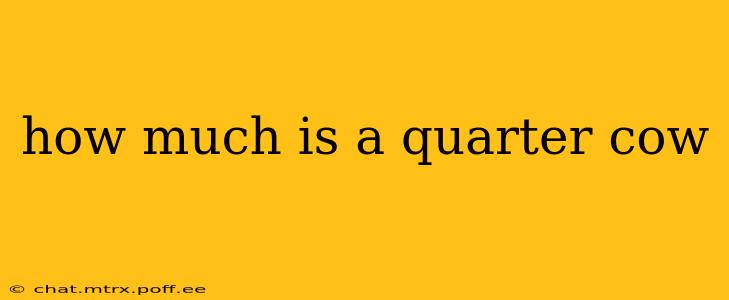How Much is a Quarter Cow? A Comprehensive Guide to Shared Ownership
The cost of a "quarter cow" isn't a fixed price. It varies significantly based on several factors, making it impossible to give a single answer. This comprehensive guide will break down the key elements affecting the price and help you understand what to expect when considering shared ownership of a cow.
What Does "Quarter Cow" Mean?
Before diving into pricing, let's clarify the term. A "quarter cow" refers to owning a one-fourth share in a single cow, typically with three other shareholders. This shared ownership model allows individuals to enjoy the benefits of owning a cow – like fresh milk, beef, or both – without the commitment and expense of owning an entire animal.
Factors Affecting the Cost of a Quarter Cow
Several factors dramatically influence the final price:
-
Breed: Different breeds of cattle have varying market values. High-quality, sought-after breeds (like Angus or Wagyu) will command a higher price per share than more common breeds.
-
Location: Geographic location impacts costs. Land prices, feed costs, and local market demands influence the overall cost of raising the cow, affecting the share price. Rural areas might have lower costs compared to areas closer to urban centers.
-
Age and Productivity: A young, productive cow will cost more than an older animal nearing the end of its productive lifespan. The expected milk or beef yield significantly impacts the perceived value and thus the share price.
-
Housing and Care: The cost of housing, feeding, and veterinary care for the cow is shared amongst the owners. Higher-quality care generally results in a higher initial cost per share. Consider whether you'll be actively participating in the care or if the arrangement includes a management fee.
-
Agreement Terms: The specific agreement between shareholders plays a crucial role. How milk or beef is divided, who is responsible for certain tasks, and the duration of the agreement all factor into the cost. A more detailed and professionally drafted agreement will likely involve higher upfront costs.
What are the Common Costs Associated with Owning a Share of a Cow?
Beyond the initial purchase price of your share, you should factor in these ongoing costs:
-
Feed: A substantial portion of the cost is feed, varying based on the type of feed used and the cow's nutritional needs.
-
Veterinary Care: Unexpected veterinary bills can arise, so budget for this contingency.
-
Housing & Maintenance: Costs associated with maintaining the cow's housing and environment.
-
Processing Fees (for beef): If the agreement involves butchering the cow, these costs will be factored into your share of the expenses.
How Much Can I Expect to Pay?
Unfortunately, there's no magic number. Prices range dramatically. You might find shares available from a few hundred dollars to several thousand dollars, depending on the factors mentioned above. The best way to find out is to contact local farmers, agricultural cooperatives, or online forums dedicated to livestock sharing arrangements in your area.
What are the Alternatives to Owning a Quarter Cow?
There are alternative options to consider if owning a share isn't feasible or appealing:
-
Community Supported Agriculture (CSA): CSAs often include meat shares from locally raised animals, providing access to high-quality products without the commitment of ownership.
-
Buying beef directly from a farmer: This allows you to source high-quality beef at potentially lower prices than retail stores while supporting local farmers.
-
Buying milk from a local dairy farm: Many local farms offer fresh milk directly to consumers, sometimes through subscriptions or on-farm sales.
By carefully considering these factors and exploring your options, you can make an informed decision about the cost and suitability of owning a share in a cow. Remember to thoroughly research potential arrangements and understand all associated costs before committing.
